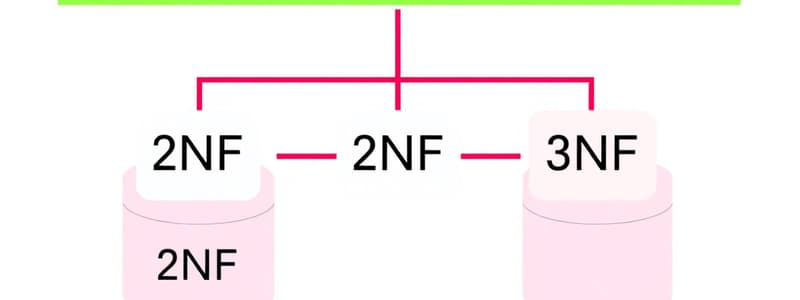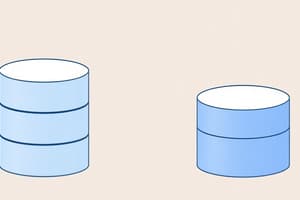Podcast
Questions and Answers
What condition must be satisfied for a relation schema R to be in second normal form (2NF)?
What condition must be satisfied for a relation schema R to be in second normal form (2NF)?
- All attributes should be dependent on multiple candidate keys.
- All attributes must depend on the whole key. (correct)
- Every non-prime attribute must be indirectly dependent on the primary key.
- All attributes must depend only on the primary key.
Which statement correctly defines a relation schema in third normal form (3NF)?
Which statement correctly defines a relation schema in third normal form (3NF)?
- Every non-prime attribute is fully functionally dependent and nontransitively dependent on every key. (correct)
- All non-prime attributes need to be dependent solely on the primary key.
- Every non-prime attribute is fully functionally dependent and transitively dependent on every key.
- All attributes must depend on both the key and an additional non-prime attribute.
What characterizes a relation in Boyce-Codd Normal Form (BCNF)?
What characterizes a relation in Boyce-Codd Normal Form (BCNF)?
- Every nontrivial, left-irreducible functional dependency must have a candidate key as its determinant. (correct)
- Only trivial functional dependencies are allowed.
- Every functional dependency must have a non-prime attribute on the left-hand side.
- All attributes must depend exclusively on the primary key.
How can a relation schema achieve second normal form (2NF) from a non-2NF state?
How can a relation schema achieve second normal form (2NF) from a non-2NF state?
Which of the following accurately describes a trivial functional dependency?
Which of the following accurately describes a trivial functional dependency?
What is required for a relation schema to be considered in third normal form (3NF)?
What is required for a relation schema to be considered in third normal form (3NF)?
In terms of normal forms, which of the following is true?
In terms of normal forms, which of the following is true?
Which functional dependency (FD) indicates a candidate key in the TEACH relation?
Which functional dependency (FD) indicates a candidate key in the TEACH relation?
What happens if a relation does not satisfy BCNF but is in 3NF?
What happens if a relation does not satisfy BCNF but is in 3NF?
Which decomposition maintains the lossless join property while sacrificing functional dependency preservation in the TEACH relation?
Which decomposition maintains the lossless join property while sacrificing functional dependency preservation in the TEACH relation?
What defines a prime attribute in the context of database normalization?
What defines a prime attribute in the context of database normalization?
What is the purpose of Boyce-Codd Normal Form (BCNF)?
What is the purpose of Boyce-Codd Normal Form (BCNF)?
Which statement is true about the relationship between 2NF, 3NF, and BCNF?
Which statement is true about the relationship between 2NF, 3NF, and BCNF?
What defines a relation to be in Fourth Normal Form (4NF)?
What defines a relation to be in Fourth Normal Form (4NF)?
Which statement is true about Fagin’s Theorem?
Which statement is true about Fagin’s Theorem?
In the CTL relation example, what does the multivalued dependency imply?
In the CTL relation example, what does the multivalued dependency imply?
What occurs when you join the two attribute projections CT and TL from the CTL relation?
What occurs when you join the two attribute projections CT and TL from the CTL relation?
Which of the following relations can be considered a projection of CTL?
Which of the following relations can be considered a projection of CTL?
What is a major characteristic of a 3-decomposable relation?
What is a major characteristic of a 3-decomposable relation?
In the EMP relation, what do the multivalued dependencies ENAME —>> PNAME and ENAME —>> DNAME suggest?
In the EMP relation, what do the multivalued dependencies ENAME —>> PNAME and ENAME —>> DNAME suggest?
Which of these options best describes a projection in database terms?
Which of these options best describes a projection in database terms?
What does it mean for a relation R to be nonloss-decomposed?
What does it mean for a relation R to be nonloss-decomposed?
Which of these attributes must be functionally dependent on A for R to meet 4NF requirements?
Which of these attributes must be functionally dependent on A for R to meet 4NF requirements?
What is required for a relation schema to be in fifth normal form (5NF)?
What is required for a relation schema to be in fifth normal form (5NF)?
Which of the following correctly describes a join dependency (JD)?
Which of the following correctly describes a join dependency (JD)?
What is the main purpose of Domain-Key Normal Form (DKNF)?
What is the main purpose of Domain-Key Normal Form (DKNF)?
Which of the following statements about join dependencies is false?
Which of the following statements about join dependencies is false?
What is a characteristic of a relation in DKNF?
What is a characteristic of a relation in DKNF?
Given the relation schema R(A,B,C,D,E) with the functional dependencies A→B, BC→E, and D→A, what is the key for R?
Given the relation schema R(A,B,C,D,E) with the functional dependencies A→B, BC→E, and D→A, what is the key for R?
Why is normalization into 5NF rarely done in practice?
Why is normalization into 5NF rarely done in practice?
In the context of the given functional dependencies, which dependency is involved in defining the implications of the keys?
In the context of the given functional dependencies, which dependency is involved in defining the implications of the keys?
Which functional dependency establishes the key for the relation R(A,B,C,D,E)?
Which functional dependency establishes the key for the relation R(A,B,C,D,E)?
In the CARSALE relation, what functional dependency indicates a non-prime attribute?
In the CARSALE relation, what functional dependency indicates a non-prime attribute?
What is the highest normal form that the CARSALE relation is in before decomposition?
What is the highest normal form that the CARSALE relation is in before decomposition?
After decomposing CARSALE based on functional dependencies, which sets of attributes belong to R2?
After decomposing CARSALE based on functional dependencies, which sets of attributes belong to R2?
In the context of the relation TRIP, which statement is true regarding the functional dependencies?
In the context of the relation TRIP, which statement is true regarding the functional dependencies?
Which of the following functional dependencies indicates a multi-valued dependency in the TRIP relation?
Which of the following functional dependencies indicates a multi-valued dependency in the TRIP relation?
How is the relation R = {A, B, C, D, E, H} classified based on the functional dependencies given?
How is the relation R = {A, B, C, D, E, H} classified based on the functional dependencies given?
What is the correct decomposition for R1 based on the dependencies for relation R?
What is the correct decomposition for R1 based on the dependencies for relation R?
Flashcards
1NF
1NF
All attributes depend on the key, every column, value that must exist, must be atomic.
2NF
2NF
All attributes depend on the whole key, for a relation to be in 2NF, it must be in 1NF and no non-prime attribute can be partially dependent on any candidate key.
3NF
3NF
All attributes depend on nothing but the key, a relation is in 3NF if it is in 2NF and no non-prime attribute is transitively dependent on any key.
BCNF
BCNF
Signup and view all the flashcards
4NF
4NF
Signup and view all the flashcards
5NF
5NF
Signup and view all the flashcards
DKNF
DKNF
Signup and view all the flashcards
Functional Dependency
Functional Dependency
Signup and view all the flashcards
Candidate Key
Candidate Key
Signup and view all the flashcards
Non-prime Attribute
Non-prime Attribute
Signup and view all the flashcards
Multi-valued Dependency
Multi-valued Dependency
Signup and view all the flashcards
Join Dependency
Join Dependency
Signup and view all the flashcards
Normalization
Normalization
Signup and view all the flashcards
Partial Dependency
Partial Dependency
Signup and view all the flashcards
Transitive Dependency
Transitive Dependency
Signup and view all the flashcards
Atomic Attributes
Atomic Attributes
Signup and view all the flashcards
Data Anomaly
Data Anomaly
Signup and view all the flashcards
Database Relation
Database Relation
Signup and view all the flashcards
Determinant
Determinant
Signup and view all the flashcards
Dependency Diagrams
Dependency Diagrams
Signup and view all the flashcards
3NF in Practice
3NF in Practice
Signup and view all the flashcards
Study Notes
Normal Forms
- 1NF: All attributes depend on the key.
- 2NF: All attributes depend on the whole key.
- 3NF: All attributes depend on nothing but the key.
Second Normal Form
- 2NF is defined for relations with multiple candidate keys.
- 2NF requires that every non-prime attribute is fully functionally dependent on every key of the relation.
- A relation is in 2NF if every non-prime attribute is not partially dependent on any key.
Third Normal Form
- 3NF is also defined for relations with multiple candidate keys.
- A relation is in 3NF if it is in 2NF and no non-prime attribute is transitively dependent on any key.
- A non-prime attribute is transitively dependent on a key if it depends on another non-prime attribute that itself depends on the key.
Boyce-Codd Normal Form
- BCNF is a stricter form of normalization than 3NF.
- BCNF requires that every determinant of a nontrivial, left-irreducible functional dependency must be a candidate key.
- BCNF ensures that every functional dependency is based on a candidate key.
Fourth Normal Form
- 4NF addresses multi-valued dependencies (MVDs).
- A relation is in 4NF if it is in 3NF and every MVD has a determinant that is also a candidate key.
- 4NF ensures that a relation is free from redundant multi-valued dependencies.
Fifth Normal Form
- 5NF addresses join dependencies.
- A relation is in 5NF if it is in 4NF and every join dependency is implied by the candidate keys of the relation.
- 5NF ensures that a relation is free from redundant join dependencies.
Domain-Key Normal Form
- DKNF is a stricter form of normalization than 5NF.
- DKNF ensures that all constraints on the relation are logical consequences of the definition of keys and domains.
- DKNF is not always achievable.
Example Problems
- Problem 1: Consider a relation R(A,B,C,D,E) with functional dependencies: A→B, BC→E, and D→A. The key for R is CD.
- Problem 2: Consider a relation R(A,B,C,D,E) with functional dependencies: A→D, C→AB, and DB→E. The key for R is C.
- Problem 3: Consider the relation CARSALE(car#, date_sold, salesman#, commission%, discount). The relation is in 1NF but not in 2NF or 3NF. Normalization can be achieved by creating three relations:
- R1(car#, date_sold, salesman#)
- R2(salesman#, commission%)
- R3(date_sold, discount)
- Problem 4: Given a relation R = {A, B, C, D, E, H} with functional dependencies F = {{A → BC}, {CD → E}, {E → C},{D → A, E, H}, {A, B, H → B, D},{D, H → B, C}}. The key for R is D.
- Problem 5: The relation TRIP (trip_id, startdate, cities_visited, cards_used) has functional dependencies: trip_id → startdate and multi-valued dependencies: trip_id →→ cities_visited and trip_id →→ cards_used. Normalization requires three relations:
- R1(trip_id, startdate)
- R2(trip_id, cities_visited)
- R3(trip_id, cards_used)
- Problem 6: A 3-decomposable relation is a relation where every tuple can be reconstructed from combining any two projections of the relation.
- Problem 7: A join dependency specifies a constraint stating that every legal state of a relation should have a non-additive join decomposition into its projections.
- Problem 8: A join dependency is a generalization of a multi-valued dependency.
Normalization in Practice
- Normalization beyond 3NF is rarely done in practice.
- 5NF is often difficult to detect and may not be achievable for a given relation.
- DKNF is optimal in terms of normalization but is not achievable for all relations.
Studying That Suits You
Use AI to generate personalized quizzes and flashcards to suit your learning preferences.




